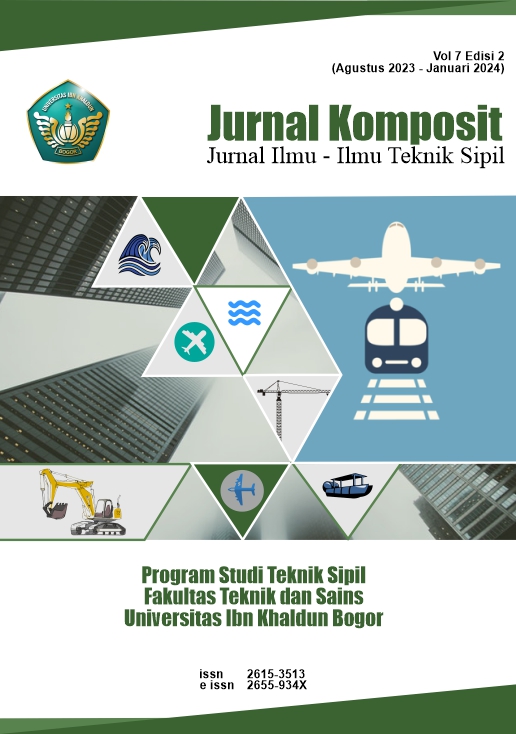Peningkatan Penggunaan Moda Non-Motorized Transport dengan Stated Preference pada Pelajar Sekolah Menengah Negeri Jakarta Pusat
DOI:
https://doi.org/10.32832/komposit.v7i2.14520Keywords:
non-motorized transport, multinomial logit, stated preferences, mode choice, transportation policyAbstract
The potential for daily trips made by students in DKI Jakarta reaches 3.8 million trips per day, or equivalent to one-fifth of all daily trips in DKI Jakarta. This study aims to look at the factors that influence student decisions when choosing school travel modes. The research sample was 573 public high school students in Central Jakarta with stratified random sampling. The method of analysis uses descriptive statistics and Multinomial Logit (MNL) with the variables stated and stated preferences. Factors that significantly influence the choice of mode of preference by public high school students in Central Jakarta are age, school level, pocket money, motorized vehicle ownership and driver's license, free bicycle facilities, Safe Routes for School facilities, school bus travel time, time spent on public transport, and private vehicle costs. The resulting model is able to influence the dependent variable by 41.4%, while the other 58.6% is influenced by independent variables outside of this study. The school zoning policy was able to convince 59% of students to switch modes to walking, while the free bicycle facility policy and RASS convinced 57.46% of students to switch modes by bicycle on school trips.
Key Words: mode choice, non-motorized transport, school travel, multinomial logit, stated preference, transportation policy
References
Adepoyibi, T., Dixon, H., Gidding, H., Taylor, R., & Morley, B. (2022). Trends and determinants of active school travel among Australian secondary school students: national cross-sectional data from 2009 to 2018. Australian and New Zealand Journal of Public Health, 46(6), 800–806. https://doi.org/10.1111/1753-6405.13315
Budiman, A., Wibisono, B. H., & Keiichi, O. (2020). Efektifitas Kebijakan Bersepeda ke Sekolah pada Program Sepeda Gratis untuk Siswa SMP Negeri di Kota Blitar, Provinsi Jawa Timur. Jurnal Kelitbangan, 8(3), 205–220. http://journalbalitbangdalampung.org
BPS DKI Jakarta. (2022). Provinsi DKI Jakarta dalam Angka 2022. DKI Jakarta: Badan Pusat Statistik.
Dave, S. M., Raykundaliya, D. P., & Shah, S. N. (2013). Modeling Trip Attributes and Feasibility Study of co-ordinated Bus for School Trips of Children. Procedia - Social and Behavioral Sciences, 104, 650–659. https://doi.org/10.1016/j.sbspro.2013.11.159
Dinas Pendidikan Provinsi DKI Jakarta. (2022). Infografis Pendidikan Tahun Ajaran 2021/2022. DKI Jakarta: Dinas Pendidikan Provinsi DKI Jakarta.
Dinas Perhubungan Provinsi DKI Jakarta. (2023). Laporan Capaian Modal Share Angkutan Umum di DKI Jakarta Tahun 2022. DKI Jakarta: Dinas Perhubungan Provinsi DKI Jakarta.
Ermagun, A., & Levinson, D. (2017). Public Transit, Active Travel, and the Journey to School: A Cross-nested Logit Analysis. Transportmetrica: A Transport Science, 13(1), 24–37. https://doi.org/10.1080/23249935.2016.1207723
Lestari, S., & Dewanti. (2021). 2021 Kebijakan Zonasi Layanan Pendidikan Surakarta. Jurnal Penataan Ruang, 16(2), 59–70.
Nevelsteen, K., Steenberghen, T., Van Rompaey, A., & Uyttersprot, L. (2012). Controlling Factors of the Parental Safety Perception on Children’s Travel Mode Choice. Accident Analysis and Prevention, 45, 39–49. https://doi.org/10.1016/j.aap.2011.11.007
Sambada, A. D. (2021). Penerapan Konsep Rute Aman Selamat Sekolah di Kawasan Pendidikan Kota Balikpapan.
Downloads
Published
How to Cite
Issue
Section
License
Copyright (c) 2023 Jurnal Komposit: Jurnal Ilmu-ilmu Teknik Sipil

This work is licensed under a Creative Commons Attribution-NonCommercial-ShareAlike 4.0 International License.
Authors who publish with this journal agree to the following terms (Penulis yang mengajukan publikasi artikel telah menyetujui hal berikut):
- Through this publication, the author agree to submit the copyright of article writing to Jurnal Komposit: Jurnal Ilmu-ilmu Teknik Sipil. This copyright submission takes the form of, but is not limited to: reproduction of the article and parts therein, including photographic reproductions; distribution of articles through printed and electronic documents; and translation of articles(Bahwa melalui publikasi ini, hak cipta penulisan artikel diserahkan kepada Jurnal Komposit: Jurnal Ilmu-ilmu Teknik Sipil. Penyerahan hak cipta ini berupa, namun tidak terbatas pada: perbanyakan artikel dan bagian di dalamnya, termasuk reproduksi fotografi; penyebarluasan artikel melalui dokumen cetak dan elektronik; serta penterjemahan artikel).
- The authors agree to the terms of the Copyright Notice, according to Creative Commons Attribution-NonCommercial-ShareAlike 4.0 International License., which will apply to this article if and when it is published by Jurnal Komposit: Jurnal Ilmu-ilmu Teknik Sipil. (Para penulis setuju dengan ketentuan Pemberitahuan Hak Cipta, sesuai dengan Lisensi Internasional Creative Commons Attribution-NonCommercial-ShareAlike 4.0., yang akan berlaku untuk artikel ini jika dan ketika diterbitkan oleh Jurnal Komposit: Jurnal Ilmu-ilmu Teknik Sipil).

This work is licensed under a Creative Commons Attribution-NonCommercial-ShareAlike 4.0 International License.



.png)










